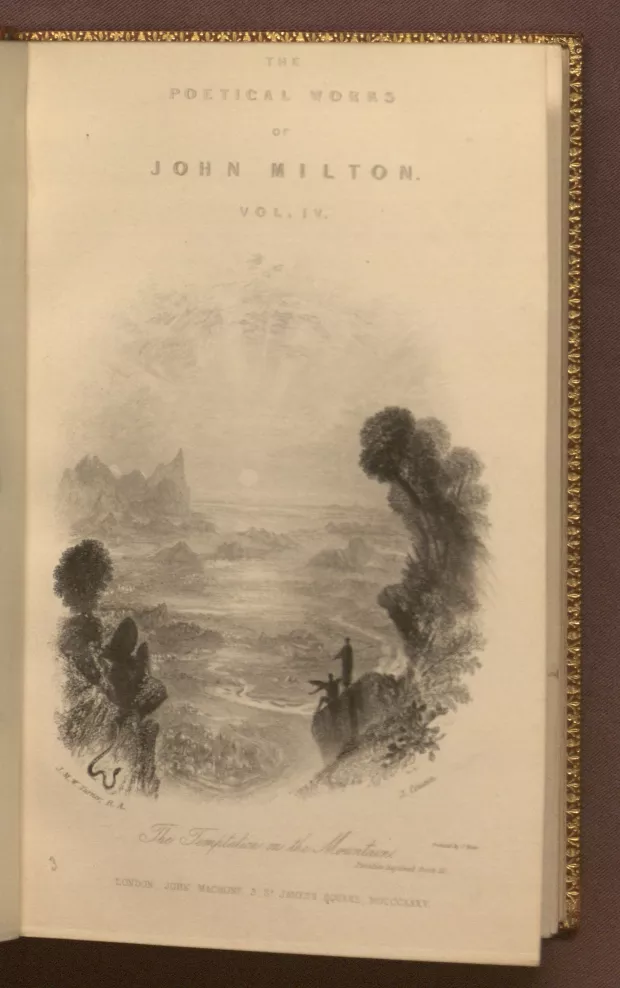Creation Date
1835
Height
11 cm
Width
8 cm
Medium
Genre
Description
The sea helps to expand the horizon of this image, increasing the territory offered to Christ by Satan, and thus increasing the potency of the temptation. The open water here creates a "stage" effect which Turner used in some of his other works: the "stage" created suggests future action. In this case, that action could be conquests on the sea. This vision of the temptation as extending to the open sea is eerily similar to the possibilities of conquest illustrated in British and American art during the Romantic era (J. Hamilton, Late Seascapes34). Satan and Jesus are silhouetted on the right at the edge of a cliff. A serpent hangs from a cliff on the left. Cities and rivers are revealed far below them, from the bottom of the print to about 2/3 up it. The land transitions into the ocean, which fades out to a less-defined horizon. The sun is centered in the top third of the image, illuminating the landscape; it appears to be either sunrise or sunset. Everything is rounded, as though it had been drawn by looking in a Claude mirror.
John Macrone, the publisher, writes in the “Advertisement” of the first volume of The Poetical Works of John Milton that he took up the project of organizing notes on Milton and Milton’s works together; the artists and engravers came to his aid when he announced the project. The image depicts the temptation of Christ by Satan, specifically the moment where Satan offers Christ the kingdoms of the world. This vision of the temptation as extending to the open sea is eerily similar to the possibilities of conquest as commonly depicted in British and American art during the Romantic era (Hamilton 34).
This is a later painting of Turner’s, and also has a biblical theme. Like The Temptation, this work includes water: a river, which blends into the skyline as a result of either mist rising from the water, fog, or low clouds (Hamilton 50). Artist Philip de Loutherbourg contributed some illustrations of chaos to Thomas Macklin’s project to illustrate the Bible. These illustrations made a profound impression on Turner in his youth (Tracy 46).
Turner’s use of shadow at the outer edges of the image—in the silhouetted Satan and Christ, the dark trees, and the shadowed cliffs—centers the viewer’s focus on the land displayed before Christ by Satan, much as if the viewer himself were standing on the cliff’s edge looking down upon the light-drenched kingdoms of the world. Turner’s choice to depict water as a part of this landscape suggests the vastness of the land: the water extends into the far distance and fades with the horizon, obscured by the intense light of the sun. A circular frame is created around the image by the surrounding figures of trees, mountains, cities, and the cliffs on which Christ, Satan and the serpent stand. This framing (as though the image were drawn using a Claude mirror) creates an open space in the forefront of the image which is reminiscent of some of Turner’s port paintings. This open space creates a “stage” effect that suggests future action, an effect explained by James Hamilton in his analysis of Keelmen Heaving Coals by Moonlight. In The Temptation, such potential action could include the conquest of new lands and victories over foreign powers enabled by access to and control over the sea. While this serves to communicate the potential value of the space which Satan offers to Christ, it also communicates the possibility of power which Turner, as a marine artist, associated with bodies of water. The potentiality of the sea, as illustrated by Turner’s vignette, explains the national appeal of laying claim to such a space.
Associated Works
Copyright
Copyright 2009, Department of Special Collections, Memorial Library, University of Wisconsin-Madison, Madison, WI
Publisher
John Macrone
Collection
Accession Number
Thordarson T 2187-2192
Additional Information
Bibliography
Bénézit, E., et al. "John Cousen." Benezit Dictionary of Artists. Vol 4. Paris: Gründ, 2006. Print.
Hamilton, James. Turner: The Late Seascapes. New Haven: Yale UP, 2003. Print.
Patten, Robert L. "John Macrone." Oxford Dictionary of National Biography. Ed. H. C. G. Matthew and Brian Harrison. Oxford: Oxford UP, 2004. Web. 1 Apr 2009.
The Poetical Works of John Milton. Vol. 4. London: Macrone, 1835. Print.
Tracy, Nicholas. Britannia's Palette: The Arts of Naval Victory. Montreal: McGill-Queen's UP, 2007. Print.

